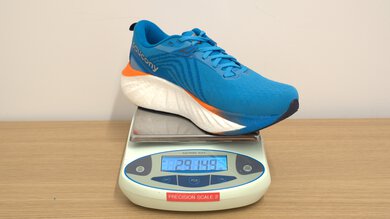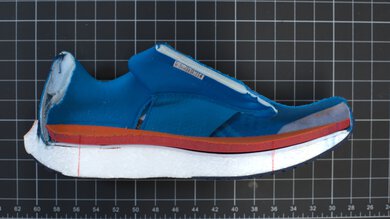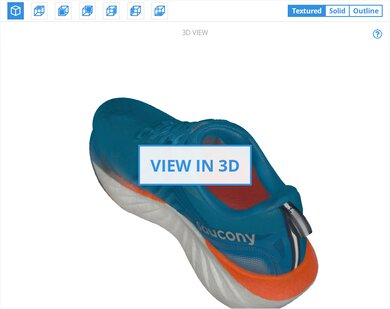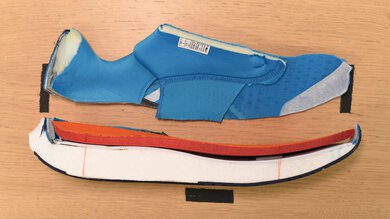The Saucony Triumph 22 is designed for runners seeking a max-cushioned, comfortable experience on long or relaxed runs. For the first time in the Triumph series, this shoe uses a version of Saucony's PEBA-based PWRRUN PB foam for its midsole, otherwise found in their more premium shoes like the Saucony Endorphin Speed 4. This shoe aims to deliver effortless transitions and reliable performance, whether you're hitting the pavement for recovery miles or leisurely runs.
Our Verdict
The Saucony Triumph 22 is an inadequate option for marathon racing due to its considerable weight, which can be a limiting factor for long-distance runs where lighter shoes are more efficient. Additionally, it lacks a plate in the midsole to add snappiness. However, the shoe offers good cushioning and lateral stability, providing comfort and support during extended runs.
-
Premium foam provides better energy return.
-
Heavy weight.
-
Unplated.
For shorter distances, the Saucony Triumph's 22 performance is not bad. The forefoot foam is quite firm, but unfortunately, that's paired with unremarkable energy return, preventing the bouncy response runners typically prefer for these distances. The lack of a plate also affects its overall performance, making it less suitable for runners looking for a fast-paced experience.
-
Premium foam provides better energy return.
-
Firm forefoot foam.
-
Heavy weight.
-
Unplated.
With the introduction of PEBA-based PWRRUN PB foam, the Saucony Triumph 22 provides acceptable energy return, especially for a max-cushioned trainer. While it's not specifically designed for speed, it can pick up the pace for a few strides if needed. However, it's not as efficient as a racer.
-
Premium foam provides better energy return.
-
Energy return is mediocre.
The cushioning in the Saucony Triumph 22 is good, providing a balanced level of comfort and protection. The heel and forefoot cushioning are well-distributed, offering a smooth ride and reducing impact on the joints.
-
High stack height.
The Saucony Triumph 22 offers good lateral stability, making it a reliable choice for runners who need extra help to stay balanced, especially on longer runs or uneven terrain. Its wide arch base plays a big role in this, creating a solid foundation that helps prevent wobbling. However, what keeps it from being exceptionally stable is its high stack height, which makes you feel elevated off the ground, and a relatively soft heel.
-
Wide outsole base.
-
Forefoot foam is quite firm.
-
Heel isn't very firm.
-
High stack height feels less stable.
- 5.7 Marathon Racing
- 6.1 5K/10K Racing
Performance Usages
- 6.4 Energy Return
- 7.8 Cushioning
- 7.8 Lateral Stability
Changelog
- Updated Apr 02, 2025: Converted to Test Bench 0.8.
- Updated Apr 02, 2025: Review published.
Check Price
Differences Between Sizes And Variants
We tested the Saucony Triumph 22 in men's US size 9, as indicated on the label. The color shown here is ViZiBlue | Pepper. This model is available in a variety of other colorways, including Cloud | Navy, Navy | Gum, White, Vapor | Moon, and Moon | Eggplant. A waterproof GORE-TEX version in a Mirage | Navy colorway is also available for both men and women.
Wide versions are offered separately for both men and women. The design section applies only to the exact model we tested, but we expect other size and gender variants to perform similarly.
Additionally, there's a Brindle version in collaboration with Nordstrom, featuring a suede and brindle hair upper. Due to the different materials, the specifications (like weight) and test results for the Brindle version may differ from the standard Triumph 22.
Compared To Other Running Shoes
As a daily trainer, the Saucony Triumph 22 caters well to runners prioritizing stability and cushioning for their easy runs. Thanks to its PEBA-based foam, it also offers acceptable energy return, especially for a daily trainer. You could pick up the pace in it for higher intensities, but due to its heavy build, it wouldn't be the ideal choice for speed. Compared to other premium daily trainers primarily designed for cruising and recovery, shoes like the Brooks Glycerin Max and the HOKA Skyward X offer even more underfoot protection, making them more appealing options for those days when your legs need a break.
Within Saucony's lineup, this shoe serves as a max-cushioned premium trainer, offering comfort above anything else. In contrast, the Saucony Endorphin Speed 4 is a lighter super trainer that returns more energy, making it better suited for faster training sessions. For those seeking even more speed, the Saucony Endorphin Pro 4, one of the brand's carbon-plated super shoe, delivers great energy return while remaining versatile enough for both racing and faster workouts.
For more options, check out our recommendations for the best running shoes.
The Saucony Triumph 22 and the HOKA Clifton 9 are two popular daily trainers that share a similar level of stability, with the Saucony having a slight edge in this aspect. However, they differ significantly in other key areas. The Saucony offers far superior cushioning and energy return compared to the HOKA, making it a great option for runners prioritizing comfort and a more bouncy ride. On the other hand, the HOKA is considerably lighter—by approximately 35 grams—making a noticeable difference for those who prefer a more effortless, lightweight feel during their runs.
The ASICS GEL-NIMBUS 26 and Saucony Triumph 22 are both premium daily trainers built for comfortable, easy runs. Both are on the heavier side, but the Triumph 22 uses a higher-end midsole that delivers more energy return and cushioning. The GEL-NIMBUS 26, on the other hand, offers a more stable ride. If you want max softness, go with the Triumph; if you value a bit more stability, the Nimbus is the better pick.
The Saucony Triumph 22 and the Saucony Endorphin Speed 4 come from the same brand but serve different purposes within a runner's rotation. The Endorphin Speed 4 is a super trainer featuring a plastic plate, which enhances stability and provides significantly more energy return. This makes it well-suited for faster-paced training and racing. The Triumph 22, in contrast, offers more cushioning, providing greater comfort for daily mileage and recovery runs. That said, the Endorphin Speed 4 is a more premium model aimed at more performance-oriented runners.
The New Balance FuelCell Rebel v4 and the Saucony Triumph 22 both cater to daily training needs, but their focus differs. The New Balance offers greater lateral stability, which benefits runners seeking a more grounded ride. The Saucony delivers a more cushioned ride, making it an option for those prioritizing impact absorption.
The Saucony Triumph 22 and ASICS SUPERBLAST 2 are both good options for daily training, but they differ in their approach. The ASICS delivers more energy return and a livelier ride, making runs feel more dynamic. Conversely, the Saucony provides a more balanced and stable platform, offering greater support throughout longer efforts.
The Saucony Triumph 22 and Nike Pegasus 41 share a similar level of stability, but their ride experience is distinct. The Nike has a more traditional design, with a lower stack height and a firmer feel. The Saucony provides a softer, more cushioned ride, appealing to runners who prioritize plush comfort during their runs.
Test Results
The shoe leans towards the heavier side, which can make it feel less nimble compared to some lighter daily trainers like the New Balance FuelCell Rebel v4.
The energy return from the heel is unremarkable—there's some responsiveness from the foam, but it lacks the springiness found in more performance-oriented shoes like the adidas Adizero Evo SL. It doesn't provide much rebound to propel you forward.
The forefoot is better than the heel at returning energy, offering a moderate bounce. While it doesn't have the aggressive snap of a super shoe, it still provides an adequate amount of energy return.
This model features good heel cushioning, delivering a mushy feel, especially for heel strikers.
The Saucony Triumph 22 absorbs a lot of energy at low forces, contributing to its plush feel—ideal for easy miles. As the forces applied increase, the energy absorption also rises (as expected with any shoe), but it does so proportionally less than other running shoes. This balance results in decent forefoot cushioning, providing comfort without feeling overly cushioned at higher intensities.
This shoe lacks rigidity in the heel, which can be good or bad. The low firmness contributes to a softer feel, which is ideal for runners seeking comfort. Unfortunately, the lack of firmness compromises the shoe's stability, and it may not perform as well in situations where a firmer heel is beneficial for control.
This shoe is really firm in the forefoot, especially under medium to high forces. This means heavier runners are more likely to feel this firmness during their runs.
Check Price
Comments
Saucony Triumph 22: Main Discussion
Let us know why you want us to review the product here, or encourage others to vote for this product.










